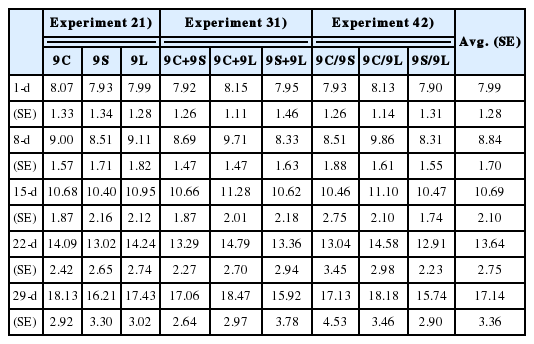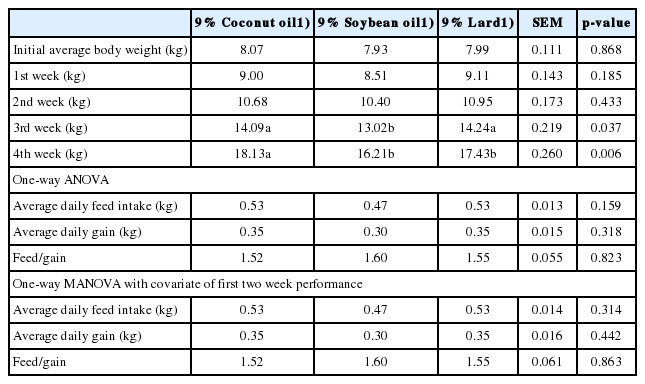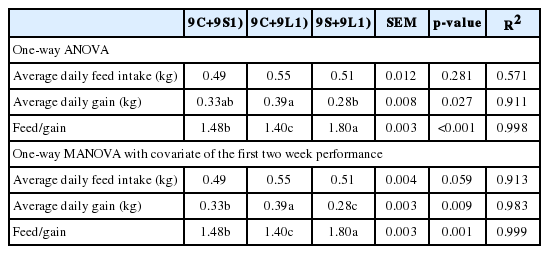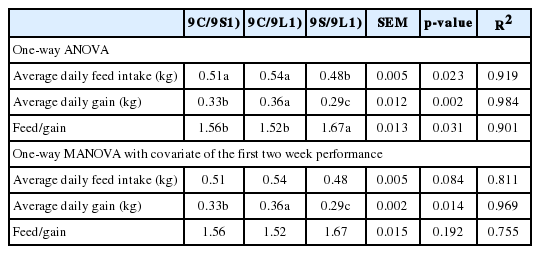Dietary fat preference and effects on performance of piglets at weaning
Article information
Abstract
Objective
An experiment was to evaluate the interplay of dietary lipid sources and feeding regime in the transition from sow milk to solid food of abruptly weaned piglets.
Methods
Soon after weaning, 144 piglets were selected and were trained over a 15 day period to experience gradually reducing dietary fat content from 12% to 6% for lard (L), soybean oil (S), and coconut oil (C) and their feeding behavior and diet preference then tested in a behavior observation experiment. Another 324 weaned piglets were used in three consecutive feeding experiments to measure the effect of different dietary fats on performance and feed choice in the four weeks after abrupt weaning. The lipid sources were used as supplements in a 3% crude fat corn/soya basal diet, with 6% of each being included to form diets 9C, 9S, and 9L respectively, and their effects on performance measured. Combinations of these diets were then further compared in fixed blends or free choice selection experiments.
Results
Piglets pre-trained to experience reducing lipid inclusion showed different subsequent preferences according to lipid source, with a preference for lard at 9%, soybean oil at 3%, and coconut oil at 6% inclusion rate (p<0.001). Following abrupt weaning, whilst after 4 weeks those fed 9C had the heaviest body weights (18.13 kg, p = 0.006). Piglets fed a fixed 1:1 blend of 9C+9S had a poorer feed conversion ratio (FCR = 1.80) than those fed a blend of 9C+9L (FCR = 1.4). The 9C and 9L combination groups showed better performance in both fixed blend and free choice feeding regimes.
Conclusion
After abrupt weaning, they still have dependence on high oleic acid lipids as found in sow milk. A feeding regime offering free choice combination of lipids might give the possibility for piglets to cope better with the transition at weaning, but further research is needed.
INTRODUCTION
Weaning is an occasion of conflict between the mother and her young over different interests which have to do with the inclusive fitness of each individual [1]. Under natural conditions piglets are generally ‘weaned’ from their mother at between 10 and 22 weeks of age [2–5]. Furthermore, when sow and piglets were housed in enriched pens, weaning was complete by 11 to 12 weeks of age [6]. Entire litters are not completely weaned at the same time; at 6 weeks of age, many un-weaned piglets received less than half of their dry-matter intake from milk [7]. In modern pig production, weaning is still associated with an abrupt dietary change, altered housing, and mixing with unfamiliar pen mates at a very young age. As a result, weaning is associated with reduced nutrient intake, immature organ function and reduced growth.
To train piglets with creep feed before weaning is a critical practice. However, creep feed intake during lactation is usually low and highly variable between and within litters [8]. Piglets consuming an average of 610 g of creep feed during lactation had an improved performance after weaning compared with control piglets without creep feed supplementation during lactation [7]. In spite of its short duration, the transition period to solid food is very important. During this period important biological events take place, and many physiological processes related with piglet growth are markedly affected by nutrient intake. One particular aspect is the change from a high intake of fat in sow milk to a low fat, cereal based diet. Therefore, the purpose of the experiments in this paper was to evaluate how the piglets adapt to the sudden weaning process under feeding regimes with different lipid sources. Lard was used to simulate the oleic acid content in sows’ milk fat, and was compared with soybean oil and coconut oil. Combinations of these three lipid sources were used to give varying levels of oleic acid (C18:1) in the diet, and the effects on performance of fixed blends were compared with the same combinations in a free choice feeding situation during the four weeks after weaning. A behavioral experiment was designed to observe the learning ability of piglets during the transition process and how they adapt to balance energy intake after weaning. Three other feeding experiments were designed to evaluate how the piglets adapt to different feeding regimes and using these lipid sources during the sudden weaning process.
MATERIALS AND METHODS
Animal care
The experiments were carried out at the agriculture college practical farm in the National Pingtung University of Science and Technology, Taiwan, ROC and were approved by the Animal Science Department Committee on Animal Experimentation of Domestic Animals.
Experimental design and animals
Experiment 1. The dietary fat preference and performance response in the weaning transition period
Soon after weaning, 144 piglets were selected from 20 litters to form 12 experimental groups, which were randomly allocated to three lipid source treatments. Each treatment had four replicate groups, with 6 barrows and 6 females randomly assigned to each group. Three lipid sources, lard (L), soybean oil (S) and coconut oil (C), were used as supplements to a 3% crude fat content corn-soybean meal basal diet formulated to 1.2% lysine (Table 1). Additions of 9%, 6%, and 3% of the experimental fat source were incorporated to form treatment diets containing 12%, 9%, and 6% crude fat respectively. The piglets were introduced to their lipid treatment in a progressive training period of 15 days, during which the dietary lipid content was 12% for 5 days, 9% for 5 days and then 6% for 5 days.
During the training period, the feeds were only offered between 06:00 to 08:00 in the morning and 18:00 to 20:00 in the evening. From day 16 to day 18, piglets were fed with 9% crude fat feeds in the morning (06:00 to 08:00) and were moved to the behavior observation pen at 18:00 for a one hour observation period before being returned to their home pen. The observation pen has 3 round troughs in different locations. The three different dietary lipid concentrations of the fat source that they had experienced during training were offered ad libitum in a choice feeding situation, with the location of each diet rotated over the three observation days according to a fully balanced design.
Experiment 2. The effects of lipid sources on piglet performance without a transition period
Soon after weaning, at 26–29 days of age, 108 piglets purchased from a commercial farm were divided into 9 experimental groups, which were randomly allocated to three lipid source treatments. Each treatment had three replicate groups, with 6 barrows and 6 females randomly assigned to each group. Three lipid sources, lard (L), soybean oil (S) and coconut oil (C), were used as supplements to a 3% crude fat content corn-soybean meal basal diet formulated to 1.2% lysine (Table 1). Addition of 6% of the experimental fat source was incorporated to form treatment diets containing 9% crude fat (9L, 9S, 9C respectively).
The piglets were introduced to the experimental diets at weaning without prior training. They were offered the allocated diet ad libitum from two individual troughs per pen for a period of four weeks, and their feed intake and growth rate were measured.
Experiment 3. The effects of combination of lipid sources on piglet performance without a transition period
Soon after weaning, 108 piglets purchased from a commercial farm were divided into 9 experimental groups, which were randomly allocated to three lipid source treatments. Each treatment had three replicate groups, with 6 barrows and 6 females randomly assigned to each group. Three lipid sources, lard (L), soybean oil (S), and coconut oil (C), were used as supplements to a 3% crude fat content corn-soybean meal basal diet formulated to 1.2% lysine (Table 1). Addition of 6% of the experimental fat source was incorporated to form treatment diets containing 9% crude fat. Diets were offered in pair combinations to give the following treatments: 9C+9S, 9C+9L, 9S+9L. The piglets were introduced to the experimental diets at weaning without prior training. The two allocated diets were mixed together in a 1:1 ratio and the mixture was offered ad libitum from two separate troughs per pen for a period of four weeks, during which feed intake and growth rate of the pigs were measured.
Experiment 4. The effects of lipid source and presentation method on piglet performance
Over a 4-week period, the growth performance of pigs given a simple free choice combination feeding regime was compared to the non-free choice (fixed combination) regime of Experiment 3. A total of 108 LYD piglets of 7 to 8 kg weaning weight were purchased from a commercial farm to form 9 groups. These groups were randomly allocated to treatments comprising a combination of two lipid sources, which were presented separately to allow free choice between them. The combinations mirrored those in Experiment 3 to give the following treatments: 9C/9S, 9C/9L, 9S/9L. Each treatment again had three replicate groups, with 6 barrows and 6 females randomly assigned to each group. The piglets were introduced to the experimental diets at weaning without prior training. The two allocated diets were offered ad libitum from two separate troughs per pen for a period of four weeks, during which feed intake and growth rate of the pigs were measured.
Behavioral data collection
All behavior observations began at 18:00 in the afternoon and lasted for 1 hour. One-minute interval scanning was used for recording the general behavior, with 3 observers recording at same time. Other observations, for which it was necessary to know more details about sequence and duration, were recorded more carefully by scanning combined with continuous observation. The time spent in the behaviors was analyzed from the recording sheet, which had the time scale on it. Behavior definitions were as follows:
Standing: maintaining an upright body position with only hooves contacting the floor.
Lying: weight of the body not supported by the legs.
Eating: head lowered into the feeding trough.
Drinking: touching the water bowl drinker with the snout, regardless of whether the piglet is actually drinking or merely manipulating the drinker.
Defecating: urinating or eliminating feces.
Moving: walking or running movements around the pen.
Rooting: touching any crate fittings or floor with the snout, including vigorous rooting and other snout contacts.
Dog-sit: partly erect on stretched front legs with the caudal end of body contacting the floor.
Chain chewing: chewing or playing with the hanging chain.
Eating frequency and preference calculations were modified from the lecture [9]. In each observed pen, eating occurrence from any of the 3 feeders was recorded for individual pigs. Preference was measured as time spent at a given feeder expressed as percentage of total eating time. The following mathematical equation was used: % Preference = ([time spent in specific feeder]/[{time spent in feeder 1}+{time spent in feeder 2}+{time spent in feeder 3}])×100%.
The body weight of each piglet was measured at day 1, 8, 15, 22, and 29. The total amount of feed consumption was also measured weekly for each group and offered feed was adjusted at day 1, 8, 15, and 22 by using the equation: feed offered per day per trough (g) = 120×(Average body weight)0.75×12 piglets. The leftover feed was removed, weighed and was not given again to the experimental groups.
Statistical analysis
One-way analysis of variance (ANOVA) using SPSS software [10] was used to compare the characteristics of general behavior in Experiment 1 and piglets’ weekly body weight in all experiments. The Levene′s test was used before a comparison of means. Comparison between treatments was done by calculating standard error of the difference between two means and least significant difference. When Levene’s test was significant, the data were tested again by Brown-Forsythe test and Tamhane’s T2 test was selected for a posteriori comparisons. When comparing effects of lipid sources, inclusion levels and their interactions on eating frequencies and preference, a factorial ANOVA with mixed design was used. The lipid sources were defined as independent factors and the inclusion levels (3%, 6%, and 9%) nested within lipid sources were defined as dependent factors. Mauchly′s sphericity W test was used to validate a repeated measures analysis of variance for prior comparisons. The treatment effects on feed intake, body weight gain and feed conversion ratio were analyzed by simple one factor analysis, with or without the inclusion of appropriate covariates; the performance of the first two weeks was used as a covariate for analyzing final performance. For investigation of the effects of treatment, the pen was considered as the experimental unit for the growth performance data, and the pig was the experimental unit for the general behavior, frequency and preference data. An α level of 0.05 was considered statistically significant.
RESULTS AND DISCUSSION
Dietary fat preference of piglets weaned with a transition process
In Experiment 1, piglets were trained to experience gradually reducing fat content dietary fat inclusion from 12% to 6% over 15 days for the lard, soybean oil and coconut oil treatments. After the transition period, piglets were moved to behavior observation pens in which 6%, 9%, and 12% fat content feeds were simultaneously presented in three individual troughs during the hour long behavior observation.
Table 2 shows the average of the time spent in each behavior during 1 hour to compare the differences between different lipid sources. There were significant differences between lipid sources for most of the observed behavior patterns. Piglets spent the longest time eating diets with soybean oil and coconut oil but the least time for lard. Lard piglets spent the longest time rooting, which was not observed in the soybean oil and coconut oil groups. Lard and coconut oil piglets moved more often and spent the longest time for chain chewing. The soybean oil piglets spent the longest time lying down, and drank more than other groups. There were no significant differences between lipid sources for standing, elimination and dog-sit.
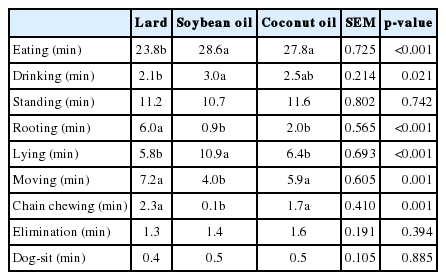
Piglet behaviors observed when offered diets containing different lipid sources measured by 1 min interval scanning for one hour of continuous observation
When comparing effects of lipid sources, inclusion levels and their interactions on eating frequencies and preference, factorial analysis of variance with a mixed design was used to analyze the differences. Table 3 shows that the interaction of fat source and inclusion level strongly affect the eating frequencies (Mauchly′s W = 0.998x2 = 0.525 p = 0.769; p≤0.001) and preferences (Mauchly′s W = 0.996x2 = 0.823 p = 0.633; p≤0.001). Lard piglets spent an average of 11.9 minutes eating 12% lard content feed and also preferred (51.3%) this feed to the other two inclusion levels. Soybean oil piglets spent an average of 14.4 minutes eating 6% soybean oil content feed and also preferred (51.2%) this feed to the other two inclusion levels. Coconut oil piglets spent an average of 12.5 minutes eating 9% coconut oil containing feed but did not show any significant preference (45.4%) for this inclusion level.
Dietary fat preference and performance of weaning piglets after a sudden weaning process
The piglets’ weekly average body weight, average daily feed intake, average daily weight gain and average feed conversion ratio in different stages were analyzed to compare performance according to dietary lipid allocation and feeding regime. The lipid sources were 9% crude fat content feeds of coconut oil (9C), soybean oil (9S) and lard (9L) in Experiment 2; these feeds were mixed in 1:1 ratio to form fixed content feeds of coconut oil and soybean oil (9C+9S), coconut oil and lard (9C+9L) and soybean oil and lard (9S+9L) in Experiment 3, while in Experiment 4 these diet combinations were offered in separate troughs to allow free choice of feeds.
Overall, performance was measured for 324 piglets with an average weaning weight of 7.99±1.276 and final body weight of 17.14±3.364 kg (Table 4). Piglets had an average of 0.15±0.036 kg daily feed intake, an average of 0.33±0.041 kg body weight gain, and an average of 1.57±0.132 feed to weight conversion ratio (Table 5) during the 4 weeks post-weaning.
The effects of lipid sources on piglet performance
Table 6 shows the average of body weight at different weeks, average daily feed intake, body weight gain and feed conversion ratio, comparing the differences between lipid sources. Piglets had similar initial body weight but those that were fed with 9C and 9L had heavier body weights at the third week after weaning, while piglets that were fed with 9C had the heaviest body weights (18.13 kg, p = 0.006) at the fourth week after weaning. The piglets that were fed with 9S had the lightest body weights at both the third and the fourth week after weaning. There were no differences in average daily feed intake (p = 0.159), body weight gain (p = 0.318) and feed conversion ratio (p = 0.823) between lipid sources during the 4 weeks post-weaning.
The effects of lipid source and feeding method on piglet performance
Table 7 shows the average of piglet performance at different weeks, comparing the different diet combinations and the interactions between fixed combinations or free choice combinations of lipid sources. As can be seen, there was a significant interaction between lipid source and feeding method on feed conversion ratio (p = 0.001), with lipid source being the main effect (p<0.001). Piglets that were fed with 9C+9S had the worst feed conversion ratio (FCR = 1.80), whereas 9C+9L piglets had the best conversion ratio (FCR = 1.4). The ratios of 9S+9L piglets were intermediate (FCR = 1.48). The 9C and 9L combination groups showed the better performance in both feeding regimes. Free choice combinations showed a better feed conversion ratio, with the exception of 9C and 9S groups.
The average daily feed intake, body weight gain and feed conversion ratio for Experiment 3 are shown in Table 8. There were no differences between lipid sources in the 4 weeks post-weaning for average daily feed intake (p = 0.218), but a significant difference was observed in body weight gain (p = 0.027) and feed conversion ratio (p<0.001). The first two weeks’ performance significantly affected daily body weight gain (p = 0.009) and feed conversion ratio (p = 0.001).
The average daily feed intake, body weight gain and feed conversion ratio for Experiment 4 are shown in Table 9. Throughout the experiment, 9S/9L piglets ate less feed (p = 0.023), gained less body weight (p = 0.002) and converted feed to gain less well (FCR = 1.67, p = 0.031). The first two weeks’ performance significantly affects the overall average daily body weight gain (p = 0.014).
DISCUSSION
At abrupt weaning, piglets have difficulties initiating dry feed intake. It takes up to 3 weeks for piglets to re-establish pre-weaning levels of energy intake, during which period their gut integrity can be compromised [11]. Maintenance of feed intake and a continuous supply of nutrients after weaning can prevent the disruption of gut structure and function after weaning [12,13]. In our results in the behavioral study, piglets spent the most time eating soybean oil and coconut oil diets, but the least time for lard diets. Lard piglets spent the longest time rooting, which was not observed in the soybean oil and coconut oil groups. These results are in agreement with the literature [14]. They observed preference differences at 3% and 10% (p<0.05), but not at 1.5% inclusion rate. They also found that, piglets preferred soybean oil at 1.5% inclusion rate (51.7%), coconut oil at 3% (53.2%) and 10% (56.8%), and lard at 10% (49.7%) by using double-choice feeding to quantify feed ingredient preferences for lipid sources.
In Experiment 1, piglets were trained to experience gradually reducing fat content in the diet (from 9% to 3% over 15 days) for lard, soybean oil and coconut oil treatments. This training process, which may assist the transition from sow milk to solid food, resulted in a preference for lard at 9% inclusion rate, soybean oil at 3% inclusion rate and coconut oil at 6% inclusion rate. The natural process of weaning is gradual, but in modern pig production weaning may be a sudden event [15]. It is hard to compare the differences between trained and untrained piglets’ performance, since they are based on different studies. Our results, in which piglets chose a higher lipid inclusion than typically offered in weaner diets and more akin to sow milk, suggest the importance of a transition period in the sudden weaning process. The importance of successful post weaning adaptation was highlighted by the observation that, in the fixed combination feeding regime, the first two weeks’ performance significantly affected daily body weight gain (p = 0.009) and feed conversion ratio (p = 0.001). This had an effect on long term daily body weight gain also being the case for the free choice feeding regime (p = 0.014).
Sow’s milk fat contains high levels of 33.3% to 37.0% palmitic acid and 37.5% to 33.0% oleic acid in the literature [16,17]. However, coconut oil, soybean oil and lard are the common lipid sources for piglet diets. The oleic acid component of lard is similar to that of sow’s milk fat, coconut oil has high percentages of short chain fatty acids and soybean oil contains high amounts of linoleic acid and linolenic acid [18]. Suckling pigs digest milk fat with a 95% digestibility, whereas fat digestibility achieved by newly weaned pigs may be as low as 73% [19]. A commercial nursery diet is typically formulated with long-chain triglyceride sources, which are less digestible than medium-chain triglycerides in the literature [20,21]. Results in neonatal pigs show that medium-chain triglycerides are absorbed and oxidized at a very high rate and, accordingly, are more ketogenic than long-chain triglycerides; therefore, one would expect that feeding a nursery diet high in medium-chain triglycerides might result in better growth performance of newly weaned pigs [22].
In Experiment 2, lard was used to simulate the high oleic acid content in sows’ milk fat, and was compared with a medium content simulant of soybean oil and lastly to a minimum content simulant of coconut oil. The performance differences were analyzed to compare and test whether the piglets still have a dependence on high oleic acid content milk-like feeds at weaning. In our results, piglets that were fed with 9C and 9L had similar, heavier body weights at the third week after weaning (p = 0.037). Piglets that were fed with 9C had the heaviest body weights (18.13 kg, p = 0.006) at the fourth week after weaning. The piglets that were fed with 9S had the lightest body weights at both the third and the fourth week after weaning. This may be because coconut oil has high percentages of short chain fatty acids, even higher than in sows’ milk fat. It is therefore seen that piglets are drawn to lipids with a high short chain fatty acid content.
Even though there was no significant interaction between feeding method and lipid source for weekly body weights, average daily feed intake and average daily gain for different treatments, some differences can be observed concerning feed conversion ratio. Piglets that were fed with 9C+9S had the worst feed conversion ratio (FCR = 1.80), whereas 9C+9L piglets had the best conversion ratio (FCR = 1.4). The ratios of 9S+9L piglets were intermediate (FCR = 1.48). Free choice combinations showed poorer feed conversion ratios; with the exception of 9C and 9S groups (9C/9S piglets were better than 9C+9S piglets). Free choice combination may offer better learning possibilities under sudden change conditions at weaning, but further investigation of this is required. It may be possible to induce a more gradual feed transition by manipulating milk intake during the lactation period. Previous results from our group reported that, in an artificial rearing condition, piglets offered creep feed were observed to wean themselves before cessation of milk availability, and the timing of this self-weaning depended on the nursing frequency. The piglets nursed at one hour intervals weaned themselves between day 22 and day 29, those nursed at 3 hour intervals weaned themselves between day 15 and day 22, whilst those nursed at 6 hour intervals weaned themselves between day 8 and day 15. The piglets which were nursed at 6 hour intervals had the highest total dry matter intake in weeks 3 and 4 when fed with milk, creep feed and water but not when fed milk only [23].
CONCLUSION
In summary, post-weaning piglets make different dietary choices depending on the lipid source they are offered. In a sudden weaning process, piglets still have a dependence on high oleic acid content milk-like feeds at weaning. They are also drawn to lipids with high short chain fatty acids content. A feeding regime with free choice combination of lipids may offer a way to aid the weaning transition, but requires further development to deliver good performance.
ACKNOWLEDGMENTS
This work was carried out with the support of the Laboratory of Animal Nutrition and Energy Resource Management, Animal Science Department, National Pingtung University of Science and Technology. We would especially like to thank Professor Sandra Edwards from School of Agriculture, Food & Rural Development, Newcastle University for providing us with a great deal of suggestions and enthusiasm throughout the discussion.
Notes
CONFLICT OF INTEREST
We certify that there is no conflict of interest with any financial organization regarding the material discussed in the manuscript.


